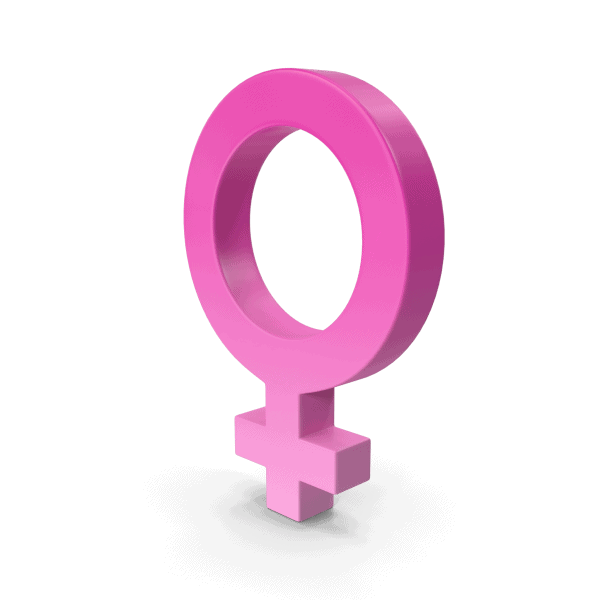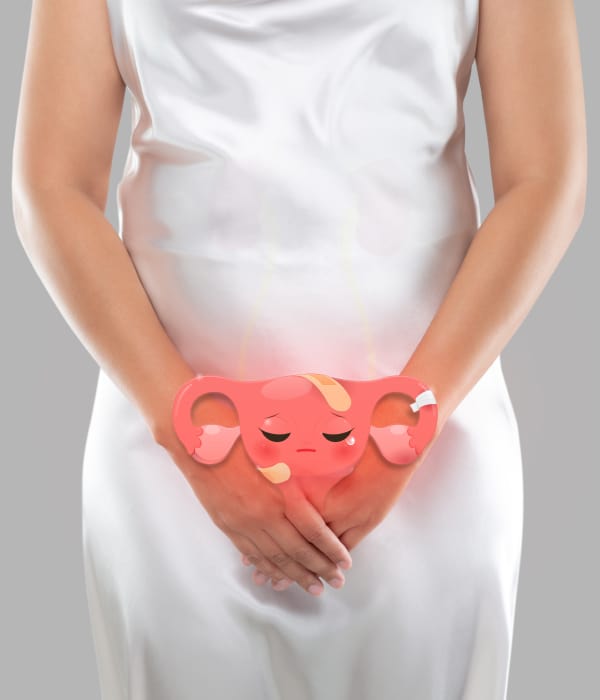Cystitis in women

Cystitis is an inflammation of the bladder mucosa manifested by often-bothersome symptoms. When the action of bacteria causes this inflammation, it is called bacterial cystitis.
Bacterial cystitis occurs much more often in women and is characterised by numerous so-called "irritative" symptoms: the woman complains of frequent urination (pollakiuria), the need to run to the toilet for a sudden and uncontrollable stimulus (urgency), burning and pain on urination (dysuria), and a feeling of painful spasm after bladder emptying (tenesmus).
Urine is cloudy and sometimes foul-smelling. Sometimes blood (haematuria) and pus (pyuria) are present in the urine. Typically, acute and uncomplicated cystitis does not cause fever.
When the fever goes above 38°C and is accompanied by chills and pain in the lower back, the infection may have spread to the kidneys. This is called acute pyelonephritis.
Chronic cystitis symptoms are like acute cystitis but in a milder form and often persist even after sterilising urine with antibiotic therapy.
The repetition of bacterial cystitis (recurrent cystitis) is a problem of significant clinical and social importance that is difficult to solve. Bacterial cystitis is recurrent when three or more episodes occur in 12 months. In adulthood, about 25–30% of women are affected at least once by bacterial cystitis; of these women, a quarter will develop a recurrence within 6–12 months.
The bacterial strain may always be the same or may vary. One type of recurrent cystitis is post-coital cystitis, which happens right after sexual activity and can significantly impact a woman's life and relationship.

Women are more likely to get bacterial cystitis and have it come back because of several risk factors:
- Menopause The deficiency of oestrogen hormones causes alteration of normal vaginal tropism, dryness and thinning of the vaginal mucosa, and a reduction of local defences.
- Previous urogynaecological surgeries, pelvic radiotherapy,
- Urine Stagnation in the bladder due to incomplete bladder emptying, obstructive anatomical situations (e.g., bladder prolapse), or poor functioning of the bladder muscle (detrusor)
- Diabetes mellitus. Diabetes mellitus is one of the leading causes of urinary infections. The presence of glucose in the urine promotes bacterial growth and damage to the neuromuscular structures of the bladder and leads to incomplete emptying of the same.
- Constipation is one of the main predisposing factors since the stagnation of faeces in the last tract of the intestine facilitates the passage of intestinal germs to the urinary tract.
- Use local birth control, like spermicidal creams or diaphragms, which can change the normal vaginal flora and provide a place for bacteria to grow.
- Inappropriate and excessive use of antimicrobial drugs alters the vaginal and intestinal bacterial balance, reducing the lactobacilli ordinarily present in the vagina and facilitating the colonisation of intestinal germs, in particular, Escherichia coli,
- The genetic predisposition to the onset of recurrent cystitis episodes may be related to an inadequate local IgA-mediated immune response or an alteration of the macromolecules lining the bladder epithelium (urothelium), protecting it from infections.
- Vitamin D Deficiency
The most frequently involved microbes are commonly found in the gut, especially Escherichia coli. Staphylococcus saprophyticus is present in 5–19% of cases, while other pathogens such as Streptococcus faecalis or Enterobacteriaceae such as Proteus or Klebsiella are often identified.
These microbes reach the most frequent bladder by ascending, consisting of the ascent of pathogens from the rectum to the vagina and then to the urethra and bladder. The blood route and the lymphatic
Laboratory diagnostics are based on a physicochemical examination of urine, examination of urinary sediment, and urine culture with an antibiogram.
The presence of bacteriuria (presence of bacteria in the urine) is associated with leukocyturia (presence of leukocytes in the urine) and sometimes with microhaematuria. An indirect sign of infection is the presence of nitrites, which are usually absent and produced by some bacterial strains. The urine culture allows disease demonstration by identifying the infecting agent, determining the bacterial load, and executing the antibiogram. This test highlights which antibiotics the germ is sensitive to, allowing targeted and rational antibiotic therapy. It is always essential to test urine along with a urine culture because a urine culture alone can be deceiving if it gives a false positive result because of contamination.
It should not be forgotten that in the absence of indirect signs of infection in the urine and symptoms, a positive urine culture should not always be treated unless found in a pregnant woman; in fact, asymptomatic bacteriuria in pregnancy should always be treated because it exposes the mother to the risk of miscarriage and premature birth.
Performing a morphological study of the urinary tract after an episode of cystitis is unnecessary. In contrast, in the case of recurrent episodes, an ultrasound study of the urinary tract should be conducted to evaluate the post-urination residue and cystoscopy in the most challenging circumstances. In the case of persistent hyperpyrexia during antibiotic treatment, more tests with instruments are needed to rule out complications like a nephroureteral calculus or the presence of a renal or perirenal abscess.
Properly treating cystitis from the first episode can stop the vicious cycle of relapses. Cystitis typically has a benign course and generally resolves with increased water intake and short-term antibiotic treatment. The therapy of lower urinary tract infections is based on antibiotic drugs whose effects on the most common uropathogenic germs are known.
Therapy should take as little as possible to minimise side effects and cost. Generally, a 3-day antibiotic treatment is sufficient to eradicate microbial infection. Some antibiotics (Fosfomycin, prulifloxacin) can be used in a single dose (one administration only). After acute therapy aimed at the primary infection solution, it is necessary to set up a plan to prevent relapses (prophylaxis) based on hygiene rules, antibiotics, and supplements. General recommendations include:
- Drink at least 2–2.5 litres of water every day.
- Avoid retaining urine.
- Use underwear made of natural fibres.
- Avoid the intake of foods and beverages that can irritate the intestines.
- Regulate the intestinal flora and use lactic acid bacteria. It is also critical to treat any associated colic pathologies.
- Avoid using too energetic intimate cleansers.
- Urine acidification
- Urinating before sexual intercourse
- Take derivatives from cranberry (proanthocyanidins) and D-mannose. These molecules, by binding to the surface structures of bacteria, prevent their adhesion to the bladder epithelium.
- Take antibiotics according to the "long-term low-dose" scheme; that is, a small dose of antibiotic, usually corresponding to half or a quarter of the total daily amount, administered in the evening, for a long time, not less than 3-6 months.
- Rebuild the tropism of the vaginal mucosa in women who have gone through menopause by putting oestrogen-based treatments (creams, eggs) in the vagina.
When these therapies do not have the desired results, it is possible to pass substances based on hyaluronic acid through a catheter into the bladder, which reconstitutes the protective layer of hyaluronic acid and glycosaminoglycans ordinarily present on the bladder epithelium.
Recurrent cystitis in women: the possible causes
20% of women develop at least one cystitis yearly, but in some patients, the episodes are repeated frequently, and then we talk about recurrent cystitis.
The cause of recurrent cystitis is found in the bacterial reservoir in the faeces, which, in certain circumstances, can infect the lower urinary tract, causing an inflammatory picture.
The likelihood of recurrent cystitis in women increases as the number of previous episodes increases. About 25% of women with urinary tract infections will have at least three relapses in the following year. In other words, after a bout of acute cystitis, the bladder organ can't defend itself against bacteria, and even with antibiotic treatment, there is a higher chance of a recurrence in the next few weeks.
But the inverse equation is also true: the longer the interval between inflammatory episodes, the less frequent recurrences are. Because of this, it is essential to take preventive steps to lower the risk of getting sick again.

There is good hydration among the general measures to be taken in cystitis; in other words, drink about 2 litres of water within 24 hours to dilute and remove any germs in the bladder.
Cystitis-recurrent-women-remedies It is also essential to regularise the intestine by resorting to a diet rich in slags—mainly fruit is taken between meals or before a meal—and, if necessary, mild laxatives. Constipation makes it easier for faeces bacteria, the leading cause of urinary tract infections, to grow.
Lactic acid bacteria by mouth and vaginally can also be used. Intimate hygiene needs to use an external lavatory with an acid pH (between 3.5 and 4.5) and dry from front to back, not vice versa, using two separate wipes for the genital areas to avoid contamination by faecal bacteria.
For many women, the torment of cystitis occurs periodically due to sexual intercourse. The most common cause is vaginal dryness or difficulty penetrating, a common problem in menopause. In these cases, intimate gels to be used during intercourse or possibly creams or eggs based on estriol, a weak oestrogen with only local effect, give more remarkable tropism to the urogenital mucous membranes very useful.
Other times, the defect is in the urethra—that duct that connects the bladder with the outside. It can be anatomical, so the external outlet is practically in the vagina, or functional, so the orgasm triggers small contractions of the urethral duct but in the opposite direction to the usual one, which goes against the current, from the outside to the inside, thus facilitating the ascent of germs. In this case, the bladder must be emptied immediately after sexual intercourse.
But for the most challenging cases, low-dose pharmacological prophylaxis can be set up with a urinary disinfectant taken once every 15 days for 3–6 months, possibly with a urine acidifier and cranberry, a natural urinary disinfectant







